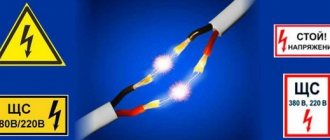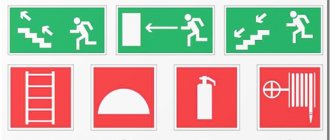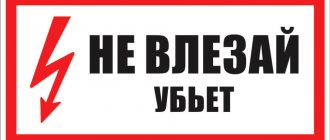Working with electricity is always associated with a certain risk, because a person can get an electrical injury not only because he neglected basic safety rules. If there are no posters and signs on electrical safety on electrical equipment, then such short-sightedness and direct violation of labor protection can easily cause an accident, and the role of information plates, leaflets, and stickers can hardly be overestimated. They are necessary to eliminate the possibility of voltage supply to electrical equipment undergoing inspection or repair, and this is far from the only area of their application, given the variety of types of posters carrying any information.
Prohibition posters
Based on the name of these posters, their main purpose is to prohibit certain actions with switching installations, so that during maintenance activities on electrical devices they are not accidentally supplied with power.
“ Working under tension. Do not turn it on again! "- no one is allowed to re-turn on the overhead line switches after they have been automatically turned off, without prior consent from the work manager. This type of poster is hung on all overhead line control keys when repair work is carried out on live equipment (U).
" Dangerous! Electric field! Passage is prohibited without protective equipment ” is installed on outdoor switchgear with U exceeding 330 kV at a height of 1.8 meters on the fences of areas with U exceeding 15 kV per meter. It informs about the high probability of dangerous effects of an electric field on operating personnel and prohibits their movement in the work area without personal protective equipment.
" Do not turn on. People are working " is a portable sign used on electrical installations with U over 1 thousand Volts. It is installed on all drives, buttons and control keys of switching equipment and means that power supply to the line is prohibited.
" Do not turn on! Work on the line "is a portable sign installed on all drives and control keys of switching devices. It prohibits power supply to the line.
Posters as one of the important elements of protection
Posters are installed to warn technical personnel about the possible danger that may come from existing electrical installations.
The posters are highlighted in bright colors and have certain inscriptions written on them.
Technical employees working with operating high-voltage equipment are provided with protective equipment.
Signs must be properly stored, transported and located in specially designated areas.
Warning posters
The main purpose of such information signs is to notify personnel about approaching at an unsafe distance to parts of equipment that are under high voltage.
“ Stop! Voltage " - used in installations with U over 1 thousand Volts. The sign notifies you of being in close proximity to live parts of an electrical installation.
" Don't get in! Will kill " - this sign informs about the danger of approaching live parts when climbing a structure.
" Trial! Danger to life " - this sign is mounted on workplace barriers during high-voltage tests and warns of the danger of electric shock.
" Carefully! Electrical voltage - used in electrical installations of any substations and power stations. It warns against the danger of approaching live parts of the installation.
Requirements for the production and operation of electrical safety signs
If you need to “leave” a sign on a stone, reinforced concrete or wooden surface, then the finished product, presented in the form of a film of the required dimensions with the appropriate inscription, is very problematic to use. Therefore, the required inscription - warning or prohibiting - is applied with paint through a stencil. A self-adhesive label can be applied to metal, painted or other smooth surfaces.
To obtain all the necessary information regarding the installation, size and shape of signs, you must read paragraph 18.5 (
Poster Conductor Sections
Electrical safety poster. Sections of Provodnikov-3
The poster shows the cross-sections of phase conductors, neutral wires, and protective conductors. For example, the cross-section of the phase conductor (and, naturally, the neutral one, because no one has canceled Kirchhoff’s first law) in power and lighting networks must be at least 1.5 mm². This is also in the PUE, but for those who like to connect additional sockets with 0.75 mm² wiring, it will be more clear on the poster.
The cross-section of the protective conductor PE in a single-phase network must be equal to the cross-section of the phase conductor. And in three-phase it may be less.
Pointing
The only instructional poster is “Grounded,” which indicates that the electrical installation is grounded and no voltage must be applied to it. Installation location – drive of switching devices. If a prohibition and an instruction sign are used at the same time, the latter must be posted in the foreground.
So we have provided posters and safety signs used in electrical installations. Please note that it is allowed to increase the size of the plates when installing them on large equipment. In this case, the magnification must be done in a ratio of 2:1, 4:1 or even 6:1. You can get additional information about sizes in SO 153-34.03.603-2003. We hope you now know what types of electrical posters and signs are divided into, and what are the conditions of use for each classification.
Finally, we recommend watching a video that explains all the safety signs:
It will be useful to read:
- Tests on the operation of electrical installations
- Programs for drawing electrical circuits
- How to become an electrician from scratch
Classification and scope of posters
According to the area of use, all plates are divided into:
- Prohibiting. They are used to prohibit any actions related to switching equipment. This refers to devices whose activation would endanger people's lives. This type of poster is used to prohibit work without protective equipment in certain industrial facilities under specific conditions.
- Warning. This type of poster is intended to inform employees or third-party visitors about the danger of electric shock. They are usually installed next to the equipment and its conductive elements. They can also be located in close proximity to electrical networks or equipment that operates under high voltage.
- Prescriptive. This type of poster allows for preventive or repair measures to be carried out at a specific point of electrical equipment. When performing a task, the employee must be guided by labor safety requirements. Such posters may indicate a safe approach to the work area.
- Index marks. Used for installation on various devices and machines that impose additional safety requirements. Can be used in conjunction with prohibition signs. But directional posters are always installed on top.
Photo gallery
Photos of the location of various signs.
Prohibiting
There are several such signs:
- “Work under voltage, do not turn it on again!” This poster indicates the prohibition of erroneous reactivation of electrical equipment without the approval of the dispatcher. We are talking about manually turning on devices after they are automatically turned off. This type of table is installed on the control elements of switches of high-voltage lines when repair or maintenance work is carried out under voltage. The poster is made in a red frame measuring 0.5 cm, the inscription is written in scarlet characters on a white background.
- "Do not turn on! People are working." This table belongs to the portable class; it is designed to prohibit the supply of voltage to the power line. The poster is installed on keys, drive devices, as well as control keys for electrical devices and devices that supply voltage to the network. According to regulations, they must be installed on electrical installations up to and above 1000 volts. The inscription is written in red letters on a white background. The frame is scarlet and its size is 1 or 0.5 cm.
- "Do not turn on! Work on the line." It belongs to the portable class and is designed to prohibit the activation of voltage on the power line. Can be installed on drive devices, as well as switching equipment control keys. Two table sizes are allowed - 20x10 and 10x5 cm. As on other signs, the inscription is made in white characters on a scarlet background.
- "Do not open! People are working." This type of prohibition poster should be installed on valves, as well as iron valves that shut off the air supply to electrical equipment. When these elements are opened, the switching device where the electricians work will be activated. This sign can be installed on gas cylinders, as well as pipelines, the opening of which could cause injury to people. This type of posters belongs to the portable class.
The channel “A Dream Turning into a Goal” talked about the rules for installing prohibition signs in accordance with safety regulations.
Warning
"Dangerous electric field" sign
This type of plate includes the following signs:
- “Stop! Voltage". A person is warned that he is in proximity to unsafe conductive lines of electrical equipment operating under high voltage. These posters have found use near electrical panels whose power ranges from 1000 volts or more. The dimensions of the plate are 30x15 cm; the poster always depicts a red lightning bolt in accordance with GOST 12.4.026. The frame width is 1.5 cm, and the inscription is always written in black characters on a white background.
- “Don’t get in! He will kill." The inscription is written along with the skull and indicates that the person is approaching live lines or parts under high voltage. A red lightning bolt is drawn on the warning sign according to GOST, and the dimensions of the poster are 30x15 cm. The width of the frame is 1.5 cm, it is always made in red. The inscription is written in black characters on a white background.
- “The test is life-threatening.” The sign warns a person that he is approaching a place where he can receive an electric shock when performing tests on high-voltage lines. This type of poster is installed on the fences of sites when carrying out any work. The dimensions of the plate are 30x15 cm.
- “Dangerous electric field” - this sign warns a person about the danger when servicing high-voltage electrical equipment. Operating personnel are prohibited from approaching switching devices without protective equipment. Such posters are placed in outdoor switchgear, where the voltage is more than 330 kV; they must be at a height of at least 150 cm from the ground. Installed on the fencing of work sites where the field strength is more than 15 kV/m. The dimensions of the plate are 20x1 cm, the frame width is 1 cm, the text is always written in scarlet letters on a white background.
- "Carefully! Electrical voltage." A warning sign within a triangle indicating a possible electrical hazard. The poster can be installed on electrical equipment of all classes and types of stations and substations, and can be used in everyday life. The sign itself is made in the form of a triangle, the sides of which measure 30 cm. They are installed on the doors of the necessary premises, the background of the poster is always yellow, and the frame and zipper are black.
Poster Formation of grounding systems
Electrical safety poster. Formation of Grounding Systems-4
The most informative poster. Half of the PUE is outlined here. Anyone who studies this poster will have 99% of questions about electrical wiring eliminated.
Let me remind you once again that posters do not replace, but complement the PUE and other normative and educational literature.
And how to print such posters on several A4 sheets - I described in detail in the article about how to print a large diagram or drawing, or a poster.
Prescriptive
This type of safety posters and signs are designed to indicate the location of work in electrical installations, as well as the safe approach to it. The kit includes:
- “Work here” - everything is simple here, the poster is used to indicate the staff’s workplace.
- “Climb Here” is intended to inform a person how to safely climb to heights to carry out work. Typically placed on stairs.
By nature of application
This classification for electrical safety posters and signs allows you to determine whether the device will be installed on a permanent basis or whether it is portable. The first, for the most part, include signs, for example, voltage indicators, which are a triangular information plate with a stylized image of lightning.
Stationary
Of the types listed above, these include the signs given in paragraphs 5 and 6, as well as the warning poster from paragraph 10
Portable
All other posters that were discussed are portable, that is, those that are installed in new places.
It makes sense to create sets of portable posters only when standard maintenance or repair of electrical network components or equipment powered by it is performed. In such cases, you can take a certain number of mandatory, prohibitive or other safety posters and signs, including “danger to life” signs, in advance.
Types of posters by purpose
These funds are classified depending on their functional purpose into the following types:
- Prohibiting action , this group imposes a ban on the use of switching equipment to prevent its activation during repair and maintenance work in the area of responsibility.
- Preventive action is prescribed to be installed in places where there is a danger of accidental contact with live parts of an electrical installation, or a danger of approaching them. In addition, this category includes a means that informs about the prohibition of entering the electric field zone without appropriate protective equipment.
- Prescriptive in nature . The purpose of these means is to point maintenance or repair personnel to a specially prepared place that meets safety standards.
- Indicating destination . Currently, GOST provides only one means for this group, informing about the imposition of portable grounding.
Let's look at what products are included in this or that group, the conditions for their use, the accepted format, as well as the acceptable colors. The sequence will be the same as adopted in GOST 12.4.026 2015 (Appendix 9).
Prohibiting
This category includes four types:
- Prohibiting the switching on of switching devices that provide power to electrical installations.
Poster “Do not turn on! People are working"
The design is made in two formats: 100.0 x 50.0 mm and 200.0 x 100.0 mm. The inscription is made in red letters on a white background. The inscription is framed with a frame of the same color as the letters. The edging has a width of 1.25 mm and is made in white.
Electrical safety rules allow the use of these safety equipment regardless of the voltage class of electrical devices. Installation is prescribed in places where switching devices are controlled, providing power supply shutdown. If the circuit diagram of the electrical device does not imply the presence of such switches, the poster is installed on the removed fuses.
- Prohibition on turning on power lines.
Poster “Do not turn on! Work on the line!
The dimensions remain standard (200.0x100.0 and 50.0x100.0). As for the inscription, it is executed inversely to the previous version, that is, in white letters. Accordingly, the colors of the edging and frame change, but their sizes remain the same.
The purpose is the same as the previous poster, adjusted for cable and overhead lines.
- Prohibition on supplying working fluid to the pipeline, opening cylinders, etc.
Poster “Do not open! People are working."
The form factor and color design correspond to the above electrical safety device from paragraph 1. This electrical protective device is installed on shut-off valves in the following cases:
- When it is necessary to prohibit the use of shut-off valves for pneumatic drives of switching devices. An example of such devices is high-voltage switches.
- If it is necessary to prevent the supply of working fluid into pipelines in order to prevent an emergency and ensure the safety of the repair team.
- Prohibition on reactivating the power line switching mode after it has been turned off. This issue must be previously agreed upon with the person responsible for safety.
Poster “Working under voltage. Do not turn it on again"
The dimensions of this type are 100.0 x 50.0 mm. Red letters are used. Installation is carried out on control keys responsible for supplying power to the power lines being repaired. This does not require de-energizing the latter.
Warning
Let's consider the safety equipment of this category, the numbering continues in accordance with Appendix 9 of the above GOST:
- Warning sign indicating possible danger of electric shock.
"Caution Electrical Voltage" sign
The sign has the shape of an equilateral triangle with a black border and a yellow background. Inside the triangle is a stylized lightning bolt. Dimensions may vary within the following limits:
For a sign installed on doors, the sides of the triangle have a length of 300.0 mm.
For various electrical installations, the following side lengths are acceptable: 25.0; 40.0; 50.0; 80.0; 100.0; 150.0 mm.
If the installation is carried out on electrical poles of high-voltage power lines, then the distance from the ground to the sign should be about 2.5-3.0 meters. It is allowed to mark supports one at a time if the span does not exceed 100.0 m. Otherwise, installation is carried out on each support.
Classification
Safety signs can be seen in the form of portable signs, posters, stencils, as well as symbols printed on the surface of the electrical installation body or fence
It is important to understand the meaning inherent in them - protection. They require appropriate behavior where they are established; they symbolize rules that cannot be violated under any circumstances. All electrical safety signs shown in the photo are standardized in size.
The text may vary depending on the scope of application and purpose
All electrical safety signs shown in the photo are standardized in size. The text may vary depending on the scope and purpose.
When they are applied to the housing or enclosure of an electrical installation, they are subject to specific requirements.
Depending on their purpose, all safety signs are divided into the following types:
- Stationary;
- Pointing;
- Prohibiting;
- Prescriptive;
- Portable;
- Warning.
Full list of posters for the first part:
The second part is here.
- Fittings of Vessels-2 – Safety Poster.jpg
- Cylinder Gas Supply-3 – Safety Poster.jpg
- Petrol Saw-1 – Safety Poster.jpg
- Gasoline Saw-2 – Safety Poster.jpg
- Petrol Saw-3 – Safety Poster.jpg
- Explosion Fire Safety-1 – Safety Poster.jpg
- Explosion Fire Safety-4 – Safety Poster.jpg
- Explosion Fire Safety-5 – Safety Poster.jpg
- External Lighting Devices_Steering Control-2 – Safety Poster.jpg
- Sling-1 Selection – Safety Poster.jpg
- Gas Welding-3 – Safety Poster.jpg
- Gas Cylinders-1 – Safety Poster.jpg
- Gas Cylinders-2 – Safety Poster.jpg
- Gas Cylinders-3 – Safety Poster.jpg
- Details Equipment Timber-3 – Safety Poster.jpg
- Chiseling Drilling-3 – Safety Poster.jpg
- Road Marking Vertical-1 – Safety Poster.jpg
- Road Marking Horizontal-1 – Safety Poster.jpg
- Arc Welding with Covered Electrodes-1 – Safety Poster.jpg
- Arc Welding with Covered Electrodes-2 – Safety Poster.jpg
- Arc Welding with Covered Electrodes-3 – Safety Poster.jpg
- Reinforced Concrete Structures-4 – Safety Poster.jpg
- Protective Equalization-2 – Safety Poster.jpg
- Protective Equipment-1 – Safety Poster.jpg
- Sign Alarm-3 – Safety Poster.jpg
- Classification of Grounding Systems-1 – Safety Poster.jpg
- Wheels Tires Engine-3 – Safety poster.jpg
- Computer Safety-1 – Safety Poster.jpg
- Computer and Security-2 – Safety Poster.jpg
- Stairs Certain Types of Work-4 – Safety Poster.jpg
- Metal rolling-2 – Safety poster.jpg
- Harness Engaging Load-2 – Safety Poster.jpg
- General Safety Precautions-1 – Safety Poster.jpg
- Bucket Excavator_Earth Work Safety-1 – Safety Poster.jpg
- Bucket Excavator_Earth Work Safety-2 – Safety Poster.jpg
- Bucket Excavator_Earth Work Safety-3 – Safety Poster.jpg
- Bucket Excavator_Earth Work Safety-4 – Safety Poster.jpg
- Burns Poisoning Frostbite-6 – Safety Poster.jpg
- Danger Zone When Operating Crane-5 – Safety Poster.jpg
- Organization for Electrical Safety-1 – Safety Poster.jpg
- Organization for Electrical Safety-2 – Safety Poster.jpg
- Organization for Electrical Safety-3 – Safety Poster.jpg
- Basic Requirements-1 – Safety Poster.jpg
- Special Conditions-4 – Safety Poster.jpg
- Stop Bleeding-3 – Safety Poster.jpg
- Shutdowns in Electrical Installations with Voltage Above 1000V-1 – Safety Poster.jpg
- Shutdowns in Electrical Installations with Voltage Above 1000V-2 – Safety Poster.jpg
Classification of information posters and signs
Electrical safety posters used in electrical installations are used to inform personnel, as well as people who value their own lives.
Perhaps the most common saying is “don’t get involved, he’ll kill you!”, and most often this inscription is accompanied by a frightening picture - a skull pierced by lightning. In general, electrical safety posters and signs are distinguished by their variety of types, so they are usually divided into several groups.
According to the installation principle, they can be both portable and stationary, and according to their purpose, they are usually classified into several groups:
- Warning signs. They “signal” that there is electrical equipment located at a short distance, close contact with which can cause electrical injury.
- Prohibiting. Such posters warn that there is a risk of being exposed to voltage. Often prohibition signs can be found on electrical equipment housings.
- Pointing. Usually installed where it is necessary to accurately show the location of portable grounding (grounding location in an electrical installation).
- Prescriptive. Indicate that all work must be carried out in full compliance with safety regulations.
It is recommended to use posters and safety signs made of plastic, which is a dielectric. If current-carrying elements of electrical installations are located at some distance, then it is allowed to use metal plates. Inscriptions on electrical safety posters and signs are applied with paints that can withstand exposure to aggressive environments: ultraviolet radiation, temperature changes, high humidity. It is noteworthy that now the necessary signs are rarely drawn through a stencil, since outdated methods have been replaced by new ones, which involve gluing a film with a ready-made image. If necessary, you should take care of the lighting.
Auxiliary signs
They are intended primarily to inform. The most common and well-known auxiliary sign is “No Trespassing”. In addition, when it comes to the repair and operation of electrical installations, signs such as “380 V”, “Equipment in operation”, “Live cable”, “High voltage cables”, “Power line security zone”, can be used. “Network division. Live cable”, etc.
Prohibition signs and posters
To prevent accidental supply of voltage when inspecting and repairing electrical equipment, prohibiting signs and electrical safety posters are used. These types of “informants” include:
- Poster “Danger! Do not enter without protective equipment!” It is a warning that a person is entering the zone of action of an electric field, and in order for him to enter, he must take care of the availability of electrical protective equipment.
- "High voltage. Life threatening!" - an electrical safety sign indicating a factor that can become a threat to human life.
- Poster “Do not turn on! People are working! “Informator” belongs to the category of non-stationary, and this inscription implies that at the current moment in time, supplying voltage is strictly prohibited. Where the poster “Do not turn on! People are working!”? For any control elements of switching devices. This is done in order to prevent the supply of voltage, and in addition, this sign is installed near the removed fuses.
- Poster “Working under voltage. Do not turn it on again." This means that you should not turn on the overhead line switches a second time if they have already been turned off. These posters are posted when live repair work is being carried out. Location – control keys.
- Poster “Do not turn on! Work on the line." Indicates that energizing the line is prohibited. The “informant” is classified as portable and is hung on control drives or keys.
Warning signs and posters
If a person approaches an unsafe distance from live elements, then warning posters and electrical safety signs will certainly notify him of this.
- “Stop! Voltage". This is a warning that a person is approaching live elements that are energized. This poster is non-stationary.
- “Don’t get in! Will kill” is a sign that is well known to everyone from childhood. A skull or lightning bolt is used as an additional “decoration”. The sign indicates that you should not climb up power lines or poles as there is a risk of electrical injury. A variant of a sadder outcome is clearly depicted in the second part of the inscription.
- Poster “Test. Life threatening!". If high-voltage tests are carried out, then such a poster will certainly be hung on the fence.
- "Carefully! Electrical voltage! - a sign indicating that there is a possibility of exposure to electric current. Very often, a yellow triangle with a black lightning bolt and a black border can be found on equipment, machines, room doors and other surfaces. It is noteworthy that this “picture” also has a second name - the sign “Danger of Electric Shock”.








